3801
Views & Citations2801
Likes & Shares
Corona viruses are a large family of viruses with some causing less-severe disease, such as the common cold, and others more severe disease such as MERS and SARS. Some transmit easily from person to person, while others do not. According to Chinese authorities, the virus in question can cause severe illness in some patients and does not transmit readily between societies (Meng, Hua, & Bian, 2020).
Globally, novel corona viruses emerge periodically in different areas, including SARS in 2002 and MERS in 2012. Several known corona viruses are circulating in animals that have not yet infected humans. As surveillance improves more corona viruses are likely to be identified.
China has strong public health capacities and resources to respond and manage respiratory disease outbreaks. In addition to treating the patients in care and isolating new cases as they may be identified, public health officials remain focused on continued contact tracing, conducting environmental assessments at the seafood market, and investigations to identify the pathogen causing the outbreak.
In the coming weeks, more comprehensive information is required to understand the current status and epidemiology of the outbreak, and the clinical picture. Further investigations are also required to determine the source, modes of transmission, extent of infection and countermeasures implemented. WHO continues to monitor the situation closely and, together with its partners, is ready to provide technical support to China to investigate and respond to this outbreak?
The preliminary determination of a novel virus will assist authorities in other countries to conduct disease detection and response. Over the past week, society with symptoms of pneumonia and reported travel history to Wuhan has been identified at international airports.
World Health Organization does not recommend any specific measures for travellers. WHO advises against the application of any travel or trade restrictions on China based on the information currently available? (WHO, 2020b).
In December, 2019, the outbreak of coronavirus takes place and initially unknown cause was detected in Wuhan (Hubei, China), and was quickly determined to be caused by a novel corona virus, namely severe acute respiratory syndrome coronavirus 2 (SARS-CoV-2). The outbreak has since spread to every province of mainland China as well as 27 other countries and regions, with more than 70000 confirmed cases as of Feb 17, 2020.
In response to this ongoing public health emergency, there was development of an online interactive dashboard, hosted by the Center for Systems Science and Engineering (CSSE) at Johns Hopkins University, Baltimore, MD, USA, to visualize and track reported cases of coronavirus disease 2019 (COVID-19) in real time.
For society with underlying health conditions, the coronavirus presents ‘all the ingredients’ for danger
An infection from the coronavirus can be a threat to anyone. But it is especially pernicious for society whose health is vulnerable, even in the best of conditions.
For some, the potential consequences of the pandemic extend to seemingly every corner of everyday life. Families of society who are most vulnerable to the virus have set up stations outside their homes to sanitize packages. Trips to the grocery store or the pharmacy have morphed into what feel like perilous excursions—every encounter with another shopper seeming like a potential danger. Appointments at chemotherapy centers are upended, as facilities limit the number of family members allowed to accompany patients (Lancet 2020).
Certain precautions are familiar. The steps that the public broadly has been urged to take in recent months—like rigorous hand washing and avoiding crowds—have been part of their defensive routines for years. These are society for whom “social distancing” is not a new concept.
“The rest of the country—and the world—are kind of getting a little bit of a taste for what we deal with on a day-to-day basis,” said John Boyle, the president of the Immune Deficiency Foundation.
But many said that because of the speed at which the virus seems to be spreading, and the sheer number of unknowns, they were being more cautious than ever.
Mental health and psychosocial considerations during the COVID-19 outbreak
In January 2020 the World Health Organization (WHO) declared the outbreak of a new coronavirus disease, COVID-19, to be a Public Health Emergency of International Concern. WHO stated that there is a high risk of COVID-19 spreading to other countries around the world? In March 2020, WHO made the assessment that COVID-19 can be characterized as a pandemic. WHO and public health authorities around the world are acting to contain the COVID-19 outbreak (WHO 2020)?
However, this time of crisis is generating stress throughout the population. The considerations presented in this document have been developed by the WHO Department of Mental Health and Substance Use as a series of messages that can be used in communications to support mental and psychosocial well-being in different target groups during the outbreak.
Psychological research on past crises can help soceity cope with the daily — sometimes hourly — newsflashes about the coronavirus-
The COVID-19 pandemic has delivered the world into uncharted waters, and researchers, health-care workers and public health authorities are scrambling to keep up. “It’s a rapidly changing landscape,” says University of California, Irvine, psychologist Roxane Cohen Silver, PhD.
HIGHLIGHTS OF WORLD HEALTH ORGANZATION (WHO)
- Since January 23rd 2020, stringent measures for controlling the novel coronavirus epidemics have been enforced and strengthened in mainland China.
- Most infected cases have been quarantined or put in suspected class, which has been ignored in existing models.
- Results of our model show that the trend of the epidemics mainly depends on quarantined and suspected cases.
- It is important to continue enhancing the quarantine and isolation strategy and improving the detection rate in mainland China.
On January 30, 2020, the World Health Organization (WHO) announced that this outbreak had constituted a public health emergency of international concern (Mahase 2020). The novel coronavirus was initially named 2019-nCoV and officially as severe acute respiratory syndrome coronavirus 2 (SARS-CoV-2). As of February 26, COVID-19 has been recognized in 34 countries, with a total of 80,239 laboratory-confirmed cases and 2,700 deaths (WHO 2020b).
Objectives of the Study
- To know the awareness level of Covid-19 in society
- To understand the COVID-19 quarantine psychological impact in Society
- To understand the COVID-19 quarantine physiological impact in Society
Hypothesis
H1. Society has high level of awareness about Covid-19
H2. COVID-19 quarantine HAVE POSITIVE psychological impact in Society
H3. COVID-19 quarantine HAVE POSITIVE physiological impact in Society
The Study
This paper aims to find out the psychological and physiological impact of coronavirus on humankind.
THE METHODOLOGY OF THE STUDY
Data Collection
The primary data was collected from the society having different psychology in terms of their age groups (Dong, Du, & Gardner, 2020). The study collected most of the data from the primary source through structured questionnaires. The Likert-type five (05) point’s scale was used to know about executives’ opinions regarding different relevant study issues. In these five (05) point’s scales 5 indicates ‘strongly disagree’; 4 indicates ‘disagree’; 3 indicates ‘neutral’; 2 indicates ‘agree’ and 1 indicates ‘strongly agree’.
Selection of Sample
The study selects a random sample of society belongs to different psychology. A sample of 210 societies were taken. All the society responded and data was collected from them via structured questionnaire which includes the questions related to psychological and physiological impact of COVID-19 on humankind.
Data Analysis
The collected data have been analyzed using a percentage method.
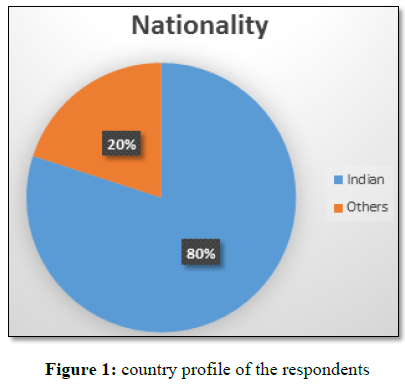
Table 1 and Figure 1 shows the country profile of the respondents. The majority of the respondents were Indians which is 80% and 20% belongs to other countries. They all were the respondents who are aware about infectious disease COVID-19.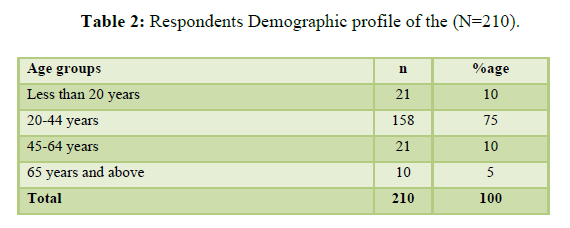
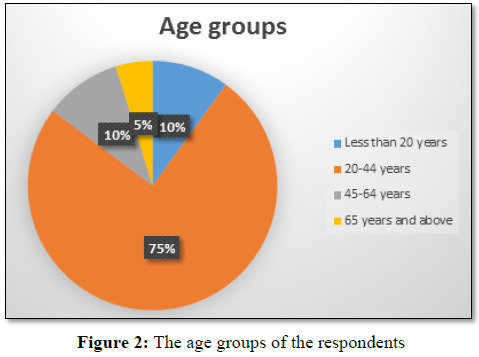
Table 2 and Figure 2 shows the age groups of the respondents. The majority of the respondents were from the age group between 20-44 years which is 75% and rest of the percentage belongs to other age groups. They all are the respondents who are having different psychological attitude.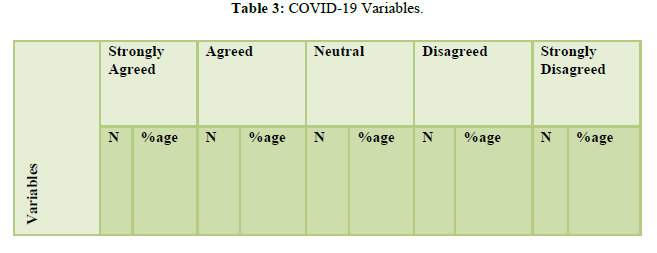

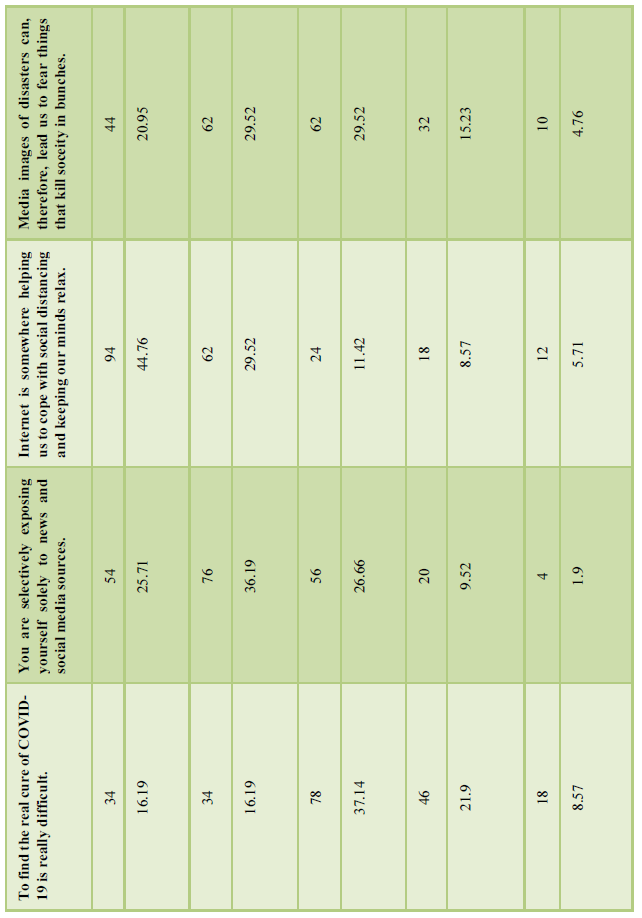
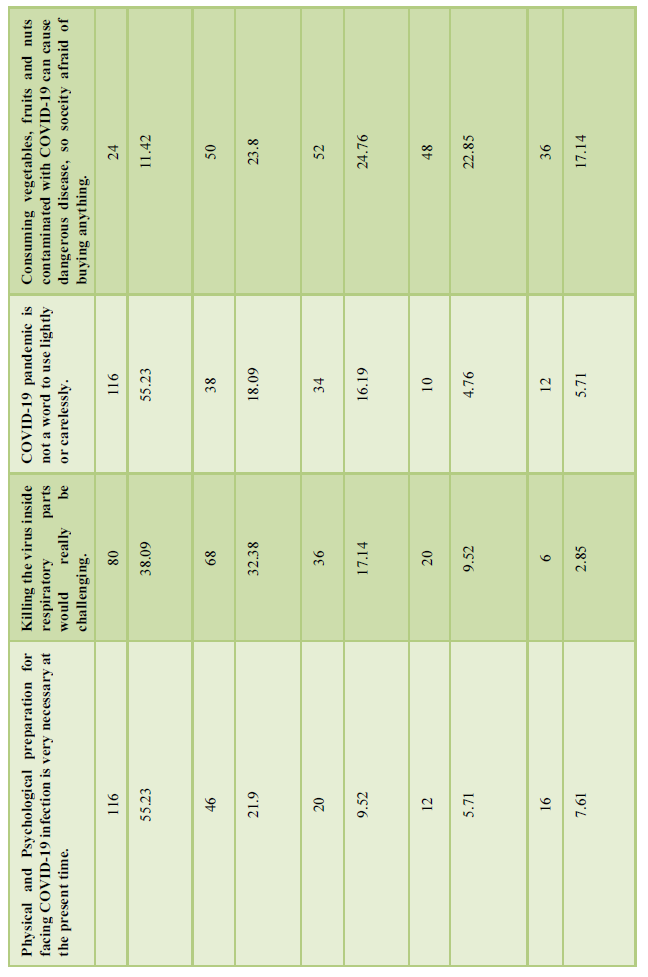
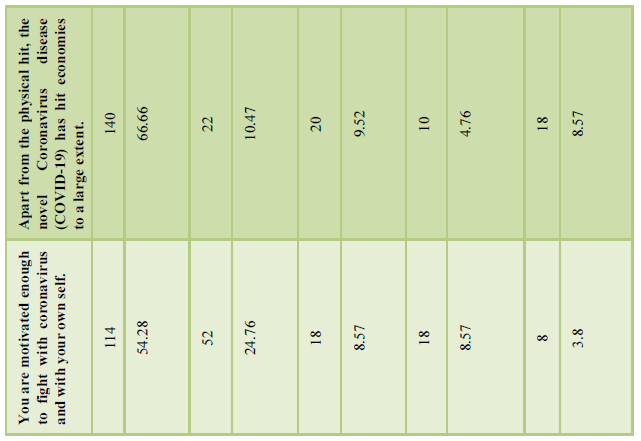
When society notice more, hear more, read more COVID-19-they interpret that in a more threatening way. The study indicates that 36.19% of the respondents were Strongly Agreed followed by 24.76% were Agreed that when they notice more, hear more and read more about COVID-19 they interpret in a more threating way. 22.85% of the respondents were neutral in their opinion. Whereas 8.57% of the local’s Disagreed and 7.61% Strongly Disagreed.
Emotions impair the perception of our risk. The study indicates that 44.76% of the respondents were neutral and 30.47% were agreed that Emotions impairs the perception of our risk. Whereas 18.09% of the respondents were Strongly Agreed. 4.76% & 1.9% of the respondents were Strongly Disagreed and Disagreed in their opinion.
Soceity probably have anxiety about it even if they feel fine. The study indicates that 39.04% & 24.76% of the respondents were agreed and Strongly Agreed that soceity have anxiety about COVID-19. 23.8% of the respondents were neutral in their opinion. Whereas 8.57% Disagreed and 3.8% Strongly Disagreed.
Social distancing is having an adverse effect on your mind and body. The study indicates that 30.47% of the respondents were neutral and 20% of the respondents were Strongly Agreed that Social distancing is having an adverse effect on their mind and body. 21.9%, 14.28% & 13.33% of the respondents were Strongly Disagreed, Disagreed and Agreed respectively in their opinion on social distancing.
Quarantining soceity may affect their mental health. The study indicates that 28.57% of the respondents were neutral and 20% of the respondents Disagreed that Quarantining soceity may affect their mental health. 22.85%, 20% & 15.23% of the respondents were Strongly Disagreed, Disagreed and Agreed respectively in their opinion on mental health.
Media images of disasters can, therefore, lead us to fear things that kill soceity in bunches. The study indicates that 29.52% of the respondents were agreed and neutral on Media images of disasters leads them to fear things that kill soceity in bunches. 20.95% of the respondents were Strongly Agreed. 15.23% & 4.76% of the respondents Disagreed and Strongly disagreed respectively.
Internet is somewhere helping us to cope with social distancing and keeping our minds relax. The study indicates that 44.76% of the respondents were Strongly Agreed that internet is helping them coping within social distancing and keeping their mind relaxed followed by 29.52% were Agreed. Neutral 11.42% were neutral in their opinion. 8.57% & 5.71% of the respondents Disagreed and Strongly Disagreed respectively.
Are you selectively exposing yourself solely to news and social media sources? The study indicates that 36.19% of the respondents were agreed followed by 26.66% were neutral about selectively exposing to news and social media sources. 25.71% of the respondents were Strongly Agreed. 9.52% & 1.9% of the respondents disagreed and strongly disagreed in their opinion.
To find the real cure of COVID-19 is really difficult. The study indicates that 37.14% of the respondents were neutral followed by 21.9% were disagreed on finding the cure of COVID-19 is difficult. 16.19% of the respondents were Strongly Agreed and Agreed. Whereas 8.57% of the respondents strongly disagreed in their opinion.
Consuming vegetables, fruits and nuts contaminated with COVID-19 can cause dangerous disease, so soceity afraid of buying anything. The study indicates that 23.8% of the respondents were neutral that soceity are afraid of buying and consuming vegetables, fruits and nuts contaminated with COVID-19 can cause the dangerous disease followed by 23.8% were agreed. 22.85% of the respondents Disagreed. Whereas 17.14% strongly disagreed and 11.42% strongly agreed in their opinion.
COVID-19 pandemic is not a word to use lightly or carelessly. The study indicates that 55.23% of the respondents were Strongly Agreed that for COVID-19 pandemic is not a word to use lightly or carelessly followed by 18.09% were Agreed. 16.19% were Neutral. 5.71% Strongly Disagreed and 4.76% Disagreed in their opinion (Mahase, 2020).
Killing the virus inside respiratory parts would really be challenging. The study indicates that 38.09% of the respondents were Strongly Agreed and 32.38% were agreed that killing the virus inside respiratory parts would really be challenging. 17.14% of the respondents were neutral. Whereas 9.52% Disagreed and 2.85% strongly disagreed in their opinion.
Physical and Psychological preparation for facing COVID-19 infection is very necessary at the present time. The study indicates that 55.23% of the respondents were Strongly Agreed and 21.9% were Agreed that Physical and Psychological preparation for facing COVID-19 infection is very necessary at the present time. 9.52% of the respondents were neutral. Whereas 7.61% strongly Disagreed and 5.71% Disagreed in their opinion.
Apart from the physical hit, the novel Coronavirus disease (COVID-19) has hit economies to a large extent. The study indicates that 66.66% of the respondents were Strongly Agreed and 10.47% were Agreed that it hits soceity physically and economically at a large extent. 9.52% of the respondents were neutral. Whereas 8.57% strongly Disagreed and 4.76% Disagreed in their opinion.
Are you motivated enough to fight with coronavirus and with your own self? The study indicates that 54.28% of the respondents were strongly agreed and 24.76% were agreed that they are motivated enough to fight COVID-19 with themselves. 8.57% of the respondents were neutral and disagreed followed by 3.8% were strongly disagreed in their opinion.
Major findings of the study are
- Soceity interpret in a more threatening way by notice more, hear more, read more about COVID-19.
- Soceity have anxiety about COVID-19.
- Internet is s helping soceity to cope with social distancing and keeping their mind relaxed.
- COVID-19 is pandemic and should not be taken lightly or carelessly.
- Killing the COVID-19 inside respiratory parts will be a challenge.
- Physical and Psychological preparation is must to face COVID-19.
- COVID-19 is physical and economies hit at a large extent.
- Self-motivation is very much fight COVID-19.
SUMMARY
In Summary, we can say that the respondents were having mix responses or opinions on various variables which were used by the researcher to know about the COVID-19. The respondents were Strongly Agreed on when they notice more, hear more and read more about COVID-19 they interpret in a more threaten way, the internet is helping them coping with social distancing and keeping their mind relaxed, COVID-19 pandemic is not a word to use lightly or carelessly. Killing the virus inside respiratory parts would really be challenging, Physical and Psychological preparation for facing COVID-19 infection is very necessary at the present time, it hits soceity physically and economically and motivated enough to fight COVID-19 with themselves. Agreed on Media images of disasters leads them to fear things that kill soceity in bunch, soceity have anxiety about COVID-19 and selectively exposing to news and social media sources. Neutral on Emotions impairs the perception of our risk, distancing is having an adverse effect on their mind and body, Quarantining soceity may affect their mental health, afraid of buying and consuming vegetables, fruits and nuts contaminated with COVID-19 can cause dangerous disease and finding the cure of COVID-19 is difficult.
- What Coronavirus Isolation Could Do to Your Mind (and Body). Social distancing can lead to adverse psychological and physiological effects. But there are things you can do to maintain your overall health. Available online at: https://www.wired.com/story/coronavirus-covid-19-isolation-psychology/
- Dong, E., Du, H. & Gardner, L. (2020). An interactive web-based dashboard to track COVID-19 in real time. The Lancet Infectious Diseases 20(5), 533-534.
- World Health Organization. (2020). WHO Statement regarding cluster of pneumonia cases in Wuhan, China. Available online at: https://www.who.int/china/news/detail/09-01-2020-who-statement-regarding-cluster-of-pneumonia-cases-in-wuhan-china
- https://www.statnews.com/2020/03/23/for-soceity-with-some-health-conditions-and-suppressed-immune-systems-the-coronavirus-is-a-life-threatening-danger/
- https://www.google.com/search?client=firefox-b-d&q=mental+effect+of+covid+19+articles#
- The Lancet. (2020). Singapore modelling study estimates impact of physical distancing on reducing spread of COVID-19. Science Daily. Science Daily. Available online at: https://www.sciencedaily.com/releases/2020/03/200324131843.htm
- Meng. L., Hua, A. & Bian Z. (2020). Coronavirus Disease 2019 (COVID-19): Emerging and Future Challenges for Dental and Oral Medicine. Journal of Dental Research 99(5), 2020.
- https://www.ijidonline.com/article/S1201-9712(20)30137-5/fulltext
- WHO: Social Stigma Associated with COVID-19: A Guide to Preventing and Addressing Social Stigma (PDF, 643KB)
- World Health Organization. (2020b). Coronavirus disease 2019 (COVID-19): Situation report-36. Available online at: https://www.who.int/docs/default-source/coronaviruse/situation-reports/20200225-sitrep-36-covid-19.pdf?sfvrsn=2791b4e0_2. Google Scholar
- Mahase, E. (2020). China coronavirus: WHO declares international emergency as death toll exceeds 200. BMJ. 368: m408.




